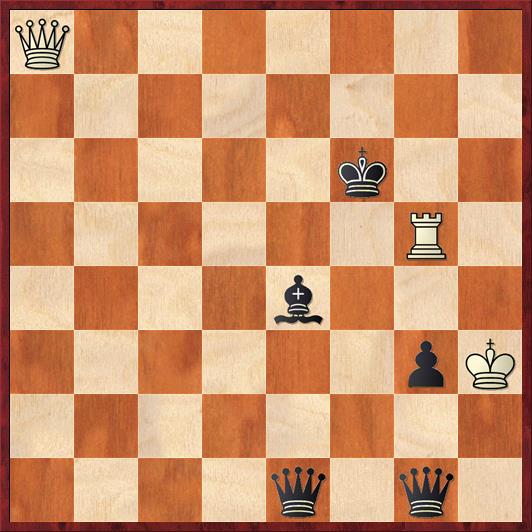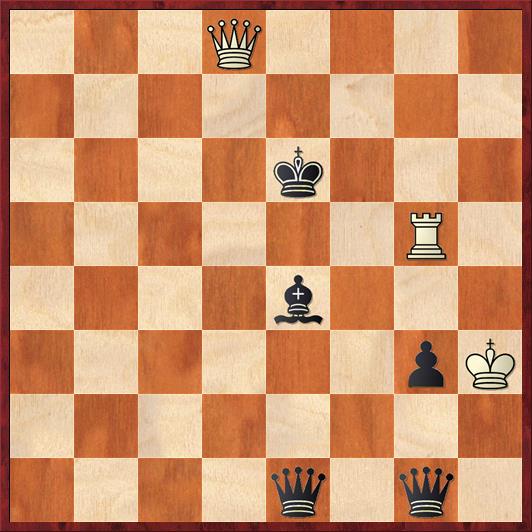One of the delightful things about running a chess club for kids is that I can watch them learn. And, sometimes, I can learn from them. Take, for example, this Tuesday, when I learned a new chess term: “robot ninja warriors.”
One of the kids, named Joaquin, called me over and said that his opponent had to leave without finishing his game, and he wondered if I could take over for his opponent. But he acknowledged that it didn’t look as if he had much chance of winning, because both his rook and his queen are under attack, and his opponent has two queens.

FEN: Q7/8/5k2/6R1/4b3/6pK/8/4q1q1 w – – 0 1
“It’s not necessarily as bad as you think,” I said. “In fact, I think you may be able to win this game! But first things first. Can you find a way to save both your queen and rook?”
Joaquin looked at the position a bit. “Aha!” he said. “I can play 1. Qg8 and defend my rook with the queen.”
“That’s true enough,” I said. “But here’s the problem. If you give the queens any chance to move, they’re going to checkmate you.”
“You mean they’re like robot ninja warriors!” he said.
Well, I didn’t quite know what that meant, but it sounded good to me. So I said, “Exactly! So, for example, if you play 1. Qg8, he can play 1. … Qh2+ 2. Kg4 Q1e2+ 3. Kf4 Qf3 mate. This is completely normal for an endgame like this. When your opponent has robot ninja warriors, you have to assume that they are going to kill you. So you can’t even let them have a chance.”
“But how can I do that?”
“You just have to play a check every move. Don’t stop checking until you checkmate him. So here, for example, on this move, you have to find a check that defends the rook.”
He looked at the position some more. “1. Qd8+!” he said.
“That’s it! Notice how the queen is protecting the rook through the king. It’s like an x-ray defense.”
At this point, let me leave the dialogue and enter analysis mode. Black can play either 1. … Kf7 or 1. … Ke6. We decided to look at the first one. We agreed that here, 2. Qg8+ looks pretty good. Now it comes with check, and the rook and queen are defending each other. Again there are two choices for Black, 2. … Kf6 and 2. … Ke7. Again, because chess club time is limited, we only looked at the first one. Then White has a very thematic win with 3. Qg7+ (which Joaquin found) Ke6 4. Re5+ Kd6 5. Qf6+!
The critical move! It would be easy for White to go wrong with 5. Qe7+ Kc6, only to discover that he can’t continue to “walk the dog” with 6. Rc5+?? because of 6. … Qxc5. By playing 5. Qf6+ White ensures that he “walks the dog” in the right direction, and Black’s robot ninja warriors can’t get involved in the defense. After 5. … K any, 6. Re7+ K any 7. Qf8 is mate. Not bad for a position Joaquin was prepared to give up as lost!
We had to leave it at that, because as far as Joaquin was concerned the game was over, and I didn’t want to harsh his buzz by insisting that we look at the other variations. Indeed, White is also winning after 1. Qd8+ Kf7 2. Qg8+ Ke7. The key to the whole position is to realize that White wants to get his queen to the f6 square with check. If he can do that, he wins. So after 3. Qg7+ Kd6, 4. Qf6+ wins immediately. Or after 3. Qg7+ Ke6, 4. Re5+ Kd6 5. Qf6+ wins. And finally, if 3. Qg7+ Ke8, again 4. Re5+ Kd8 5. Qf6+ wins.
But here’s a more challenging question: What if Black replies to 1. Qd8+ with 1. … Ke6? Is it a win, draw, or loss for White? I found this really interesting to work out. Of course, a computer figures it out in a second, so no peeking.

FEN: 3Q4/8/4k3/6R1/4b3/6pK/8/4q1q1 w – – 0 2
I’ll leave this as a challenge for my readers, but I’ll give you one hint. Just as White has a key objective (to play Qf6 with check), Black also has an objective: to reach a6 or b6 with his king, so that Qf6+ can be met by … Bc6 or … Qb6.
I like the way that chess positions can be understood at many different levels. On Joaquin’s level, the key lessons are (1) when your opponent has robot ninja warriors, you can’t even let them check you once, and (2) it is vital for White to understand the “walking the dog” procedure for winning with queen and rook. It’s even more important here than it is in a standard K+Q+R vs. K endgame, because here, if you don’t succeed in setting up the “walking the dog” pattern, you’re going to lose. By contrast, in K+Q+R versus K, if you don’t get it right the first time, you’ll get lots of second chances.
On a more advanced level, we have a formidable analytical challenge after 1. Qd8+ Ke6, and you’ll probably get lost unless you apply some form of schematic thinking. White formulates a goal, Black formulates a goal, and then it’s all about which player can achieve his goal and stop the opponent’s.


